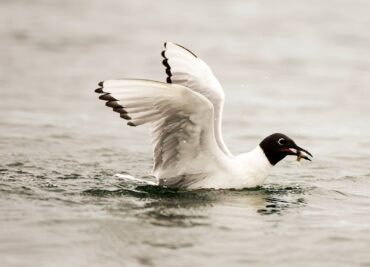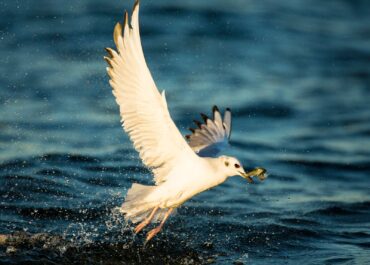
Gulls. Often erroneously calling them “seagulls,” people either despise or delight in them. As scavengers, gulls keep our beaches clean. As social birds, they can be hilarious to watch, thanks to their antics, especially when fighting over the delectable flesh of dead, smelly sea creatures that have washed ashore.
Nearly a quarter of the world’s 50-plus species of gulls are regularly found in Washington. Rarities from other regions occasionally join them, particularly in winter and during the fall migration.
In West Sound, nine different kinds of gulls are relatively easy to find each year, particularly in estuaries and on sandy marine beaches where gulls like to congregate.
Gulls come in all sizes: small, medium and large. Most of West Sound’s gulls belong in the medium and large categories, making the lone resident small gull reasonably easy to spot.
The Bonaparte’s gull (named for ornithologist Charles Lucien Bonaparte, nephew of Napoleon Bonaparte) is the smallest resident gull in Washington and one of the smallest in the world. It breeds in small colonies in the boreal forests and wetlands of Alaska and Canada. It winters along the Atlantic and Pacific coasts and in states bordering the Gulf of Mexico.
In West Sound, Bonaparte’s gulls are most commonly observed in summer, fall and winter. Migrating flocks often number in the hundreds or even thousands. They are typically found along saltwater shorelines that border Puget Sound. Occasionally, they are seen along Hood Canal.

The best places to observe Bonaparte’s gulls include the beaches of Hansville (particularly Point No Point County Park), Eglon, estuaries of Bainbridge Island and the various ferry terminals and ferry routes across Puget Sound.
The Bonaparte’s gull is the only gull species known to regularly nest in trees. It prefers a black spruce or jack pine branch, over or near water, on which to build a sturdy nest cup of twigs and moss. Two or three eggs are laid, which both parents take turns incubating for 24 days. Hatchlings are cared for by both parents, at least until they are ready to fledge.
This bird is one of six gulls of North America that sports a black head during the breeding season, which it takes two years to obtain. In the nonbreeding season, the black head turns white, with a single dark spot near the ear. Other identifying field marks include a black bill and black edges on the upper wings. Legs are orange in the breeding season and pink in the nonbreeding season.
The Bonaparte’s gull is about the size of a rock pigeon. Occasionally, a flock of Bonaparte’s gulls may be joined by a single little gull, the smallest gull in the world. Normally a resident of the East Coast, the little gull is most easily distinguished from the Bonaparte’s gull by its smaller size, dark underwings and more rapid wingbeats.
Being small and light makes the Bonaparte’s gull an agile flyer, a graceful swimmer and an efficient runner, allowing it to successfully find sustenance in the air, in the water and on land. Taking flight from the water is no problem, as it projects itself into the air like a torpedo, even from beneath the surface.
During breeding season, the Bonaparte’s gull primarily eats insects it catches while in flight. The rest of the year, it mostly feeds on small fish caught near the surface of the water, often diving in after a fish it has spotted while hovering in the air above. It also consumes freshwater and marine invertebrates on or near the shore.
Bonaparte’s gulls are absent from garbage dumps, preferring to consume only natural food. While they often feed near tidal rips and upwellings where bait balls of forage fish are prevalent, wintering flocks sometimes venture farther from the coast than most gulls, traveling 10 miles or more offshore.
Because of its diminutive size, the Bonaparte’s gull is sometimes bullied during the fall migration by the intimidating parasitic jaeger, a bigger gull-like seabird with a pointed tail. The parasitic jaeger harasses its victim by flying closely behind it, even keeping pace in tight turns, until the Bonaparte’s gull has had enough and regurgitates its latest meal. The jaeger then ends the chase and drops to the surface to consume the recycled food. This behavior is commonly observed at Point No Point County Park in late summer.
Populations of Bonaparte’s gulls appear to be stable. But like other marine species, they are susceptible to toxins in the environment and habitat disturbance in nesting areas.
The Bonaparte’s gull is the exception for those who consider gulls to be ordinary and uninteresting. These fast-moving gulls with marvelous maneuverability can really entertain as they dive for fish and try to evade parasitic jaegers who want their lunch. So head to the beach and enjoy the show!

























